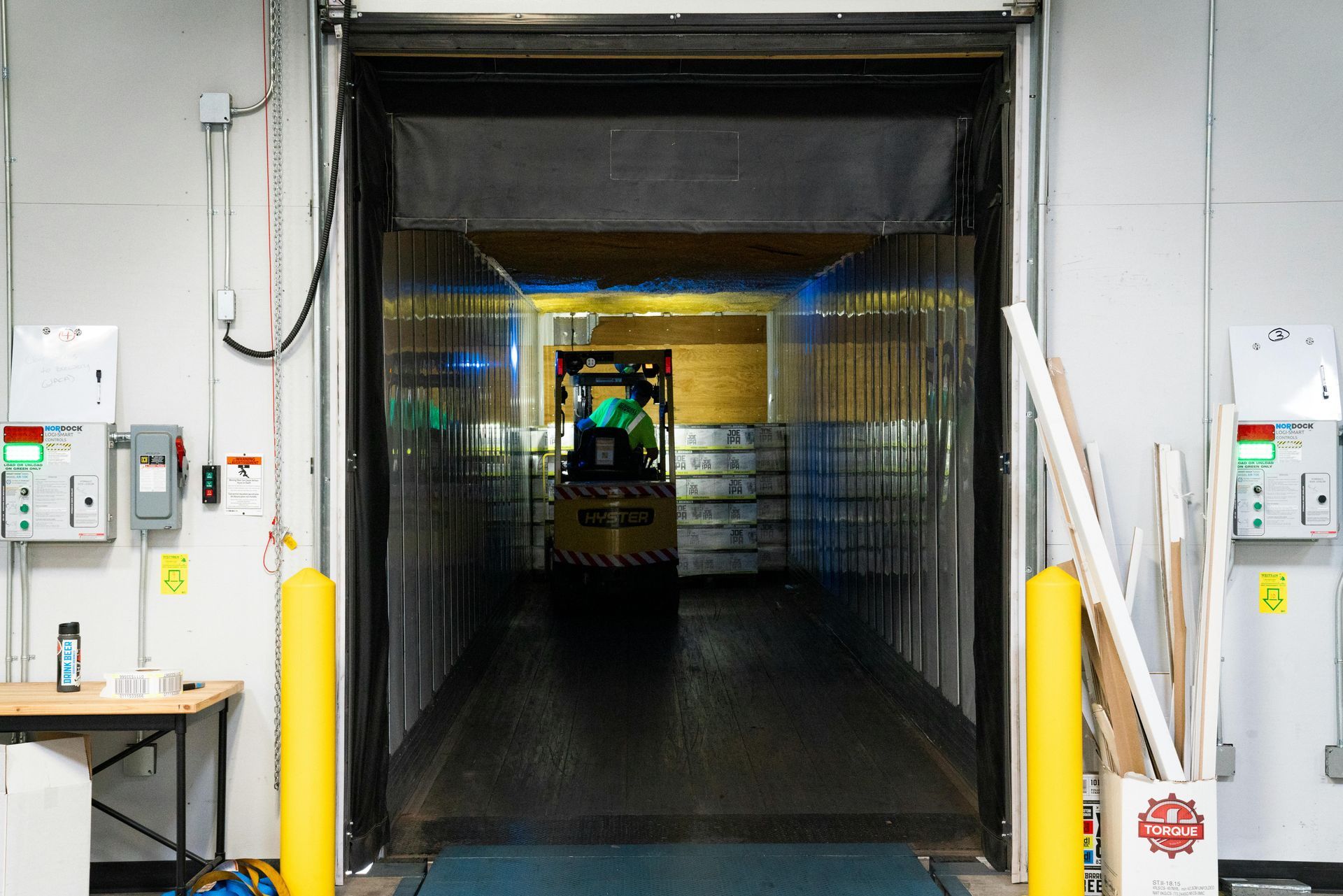The Complete Guide to Loading Dock Levelers for Your Business
Choosing the right loading dock leveler means matching it to your dock size, load weight, and ease of use—whether hydraulic for smooth power or mechanical for budget-friendly jobs. This equipment boosts safety and speed, and keeps things steady between your dock and trucks. Just don’t skip proper installation and regular upkeep; a well-maintained leveler is your dock’s best friend. Here, learn how to keep your dock safe and efficient like a pro.
Key Takeaways
- Choose the right type of dock leveler (hydraulic, mechanical, edge of dock, portable, vertical) based on load capacity and operational needs.
- Ensure compliance with OSHA by installing guardrails, safety chains, clear warnings, and accessible controls for safe dock operations.
- Install dock levelers precisely with proper frame alignment, centered positioning, and secure fastening to prevent uneven wear and accidents.
- Perform routine maintenance including cleaning, lubrication, bolt inspections, and functionality testing to extend leveler lifespan and reliability.
- Train employees thoroughly on safe equipment use, hazard awareness, and proper PPE to enhance workplace safety and operational efficiency.
Understanding Different Types of Loading Dock Levelers
The subject of loading dock levelers may seem minor, but knowing the different types can really save you a headache down the line.
There are several main types of levelers: hydraulic levelers, mechanical levelers, edge-of-dock, portable levelers, and vertical levelers.
Hydraulic levelers use fluid power to smoothly bridge gaps, making them great for heavy loads and boosting operational efficiency. Mechanical levelers rely on springs or manual lifting, usually coming with lower installation costs but might require more elbow grease. Edge-of-dock levelers attach right to the dock, saving space and simplifying setup. Portable levelers are handy if you need flexibility, easy to move around, but watch their weight capacity. Vertical levelers lift straight up, saving dock space and offering some cool safety features.
Each type has its own load capacity and safety features, so picking the right one means your team works more safely and smoothly.
Key Features to Consider When Choosing a Dock Leveler
Selecting a dock leveler doesn't mean installing one randomly and then forgetting about it. You want to choose something reliable that fits your business purposes.
Here are four key features to consider:
- Load Capacity – Make sure the leveler can handle the heaviest loads you expect. No one wants a flimsy platform that wobbles under pressure.
- Dock Leveler Materials – Steel is tough and durable, but aluminum is lighter and resists rust. Think about your environment and how much wear and tear you expect.
- Size and Fit – It’s gotta match your dock’s dimensions perfectly. An ill-fitting leveler is like a square peg in a round hole—just won’t work smoothly.
- Ease of Operation – You want your team to move goods quickly without wrestling with complicated mechanics. Simple is smart.
Benefits of Installing a Loading Dock Leveler
A loading dock leveler boosts safety by smoothing out those tricky gaps between your dock and trucks. It also speeds up loading and unloading, saving you time and headaches. Plus, it works with all kinds of equipment, making your workday run a lot smoother.
Enhanced Workplace Safety
Because loading docks can be busy and tricky spots, having a leveler makes a big difference in keeping everyone safe. When you invest in a loading dock leveler, you’re not just upgrading equipment but enhancing your team’s safety.
Here’s how it helps:
- It smooths out uneven surfaces, cutting down trip hazards during those hectic loading times.
- Built with ergonomic design, it reduces strain on your crew, making their work easier and preventing injuries.
- It supports thorough risk assessment by minimizing dangerous gaps between the dock and the truck.
- Its sturdy build keeps heavy loads steady, so no surprises that could cause accidents.
Improved Loading Efficiency
Even with a loading operation that's already running smoothly, adding a dock leveler can considerably speed things up. It bridges the gap between your dock and trucks, making it easier and faster to move goods. This boost in loading speed means your team spends less time waiting around and more time getting stuff done.
Plus, smoother loading cuts down on mistakes and damage, which helps keep operational costs in check. When everyone works together with the right tools, the whole process feels less like a hassle and more like a well-oiled machine.
You’ll notice your crew’s morale improving too, because they’re not maneuvering heavy load over uneven surfaces.
Bottom line: a dock leveler can make your daily grind quicker and easier, and that’s something we all want.
Versatile Equipment Compatibility
While it might seem like a small detail, a loading dock leveler is compatible with other equipment that you already use. That’s the beauty of equipment adaptability in loading solutions: it fits your setup without fuss.
Here’s why versatile equipment compatibility matters:
- Forklifts glide smoothly over the leveler, cutting down bumps and spills.
- Pallet jacks slide in without a hitch, speeding up your loading game.
- Dock plates and shelters sync up perfectly, sealing the deal on safety.
- Automated systems mesh well, making your workflow a breeze.
Proper Installation Practices for Dock Levelers
Getting your dock leveler installed right the first time can prevent future problems. By following the proper installation guidelines, you can be sure that your leveler fits perfectly and works smoothly. Don’t rush the job; take time to check the frame alignment and make precise leveler adjustments. This helps avoid costly repairs and keeps your loading dock safe for everyone.
Here’s a quick look at key installation steps:
| Step | What to Do | Why It Matters |
|---|---|---|
| Frame Alignment | Use a level & measure twice | Prevents uneven wear |
| Leveler Position | Center under dock opening | Guarantees smooth operation |
| Secure Fastening | Tighten bolts & check welds | Keeps the equipment sturdy & safe |
Routine Maintenance Tips for Longevity and Performance
Since your dock leveler works hard every day, it needs a little TLC to keep running smoothly. Routine maintenance ensures the leveler's longevity and exceptional performance.
Here are some easy preventative care tips you’ll want to follow:
- Clean it up: Dirt and debris can gum things up, so keep the surface and hinges tidy.
- Lubricate moving parts: A little oil goes a long way in avoiding squeaks and wear.
- Inspect bolts and welds: Tighten anything loose and look for cracks during your performance checks.
- Test regularly: Run the leveler through its paces to catch issues early.
With these tips, your dock leveler can stay on commission for years of reliable service.
Common Problems and How to Troubleshoot Them
Even the toughest dock levelers can sometimes run into hiccups. When dock leveler issues come up, they usually fall into common categories like sticking platforms, slow operation, or hydraulic leaks.
First, check for debris or rust causing the platform to stick—that’s an easy fix. If it’s moving sluggishly, your troubleshooting techniques should include inspecting the hydraulic fluid level and topping it off if needed.
For leaks, keep an eye on hoses and seals; replacing worn parts often solves the problem. Remember, sometimes a quick visual check saves you a headache later.
You’re part of a community that handles these hiccups with confidence, so don’t hesitate to reach out to pros if things get tricky. With a bit of patience and these solid troubleshooting techniques, you’ll have your dock leveler back in top shape faster than you think.
Safety Measures and Compliance Standards for Dock Levelers
You have to keep safety front and center when using dock levelers, and that means following OSHA rules to the letter.
Regular maintenance is a must to keep everything running smoothly and to avoid unforeseen incidents. In addition, training your team on how to use the equipment safely can save you from headaches and maybe even a few bruised egos.
OSHA Compliance Requirements
When you’re setting up loading dock levelers, OSHA rules should be followed not only for compliance but also to keep everyone safe and sound. Here’s a handy compliance checklist to help you out:
- Make certain guardrails and safety chains are in place to prevent falls.
- Verify that the leveler can support the maximum intended load without issues.
- Check for clear, visible warning signs around the dock area.
- Confirm that the leveler’s operation controls are easy to access and understand.
Regular Maintenance Protocols
Once your loading dock levelers meet OSHA’s safety rules, the next step is to maintain them. You’ll want to set up regular preventive inspections to catch any small issues before they turn into big headaches. Sticking to maintenance schedules isn’t just about ticking boxes: it helps your team work smoothly and safely.
Employee Safety Training
Although dock levelers are built tough, they’re only as safe as the people using them. That’s why solid employee safety training is a must. When you boost employee engagement with smart training programs, everyone feels more confident and connected.
To form an effective operator training program:
- Create hands-on sessions so folks learn by doing, not just listening.
- Keep safety talks regular and fun — no one likes a snooze fest.
- Encourage questions and share stories; it helps everyone feel part of the team.
- Review compliance standards often to stay on track and avoid surprises.
Frequently Asked Questions
How do loading dock levelers affect warehouse workflow efficiency?
You’ll boost operational productivity by using loading dock levelers, which improve workflow efficiency and loading dock safety. They help your team work smoothly, reducing delays and accidents, so everyone feels connected and valued.
What Is the average lifespan of a loading dock leveler?
Think of your loading dock as a reliable bridge; with a solid maintenance schedule, your dock leveler typically lasts 10-15 years. By caring for it, you join a community valuing efficiency and lasting performance.
Are there financing options available for purchasing dock levelers?
You’ll find various financing options tailored to your needs, making it easier to invest in dock levelers. Plus, many suppliers offer purchase incentives to welcome you into a community focused on efficiency and growth.
Can dock levelers be customized for unique dock heights?
You can definitely get custom dock solutions tailored to your unique dock height adjustments. We recognize your needs and want you to feel part of a community that values precise, effective dock equipment built just for you.
What are the environmental considerations for dock leveler disposal?
You might be surprised, but improper disposal harms more than just your site. You’ll want to follow environmental regulations closely and explore dock leveler recycling options.
Final Thoughts
Think of a
loading dock leveler like the trusty bridge in a busy town: it keeps everything moving smoothly, no matter the traffic. Similar to how that bridge needs
regular check-ups, your dock leveler needs care and the right pick to avoid hiccups. With the tips in this article, you can save time, money, and headaches, and make sure that your business runs like clockwork.
Upgrade your operations today! Our expert team can help you choose the right loading dock leveler to keep your workflow safe, smooth, and efficient.
Reference:
https://www.osha.gov/laws-regs/regulations/standardnumber/1910/1910.26
Share this article



